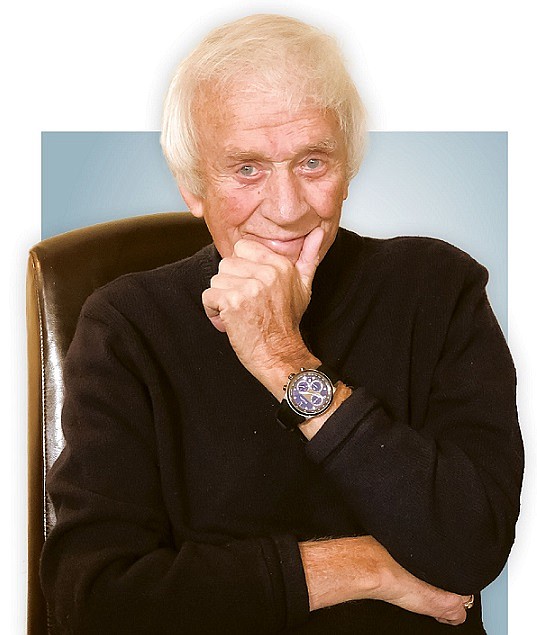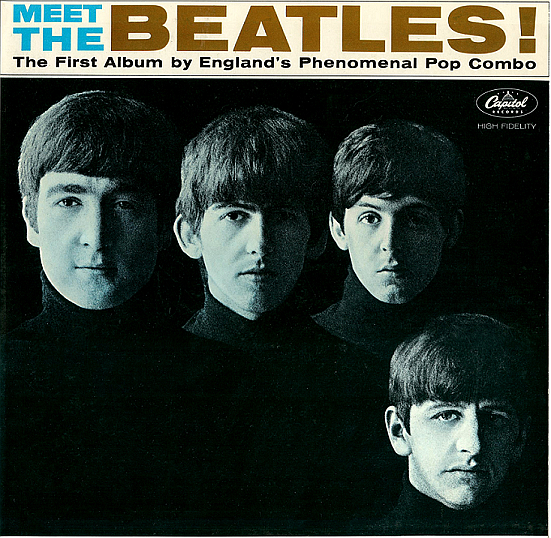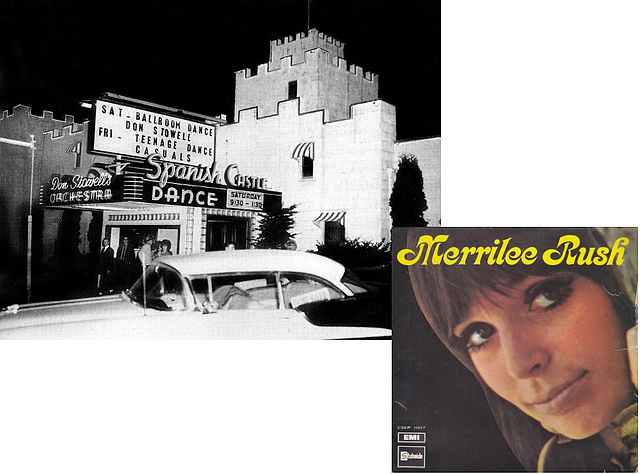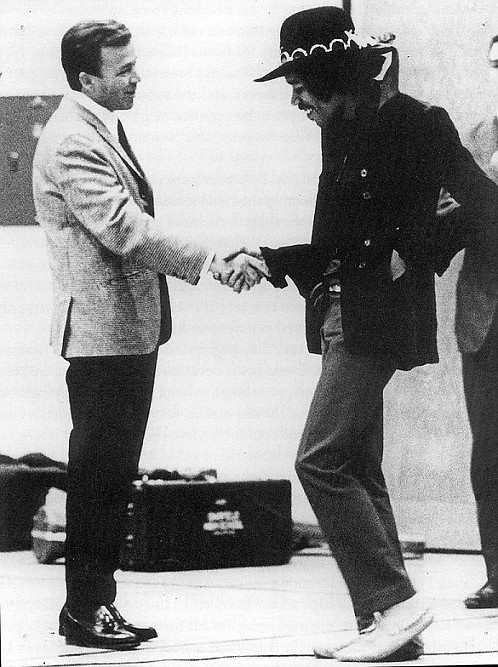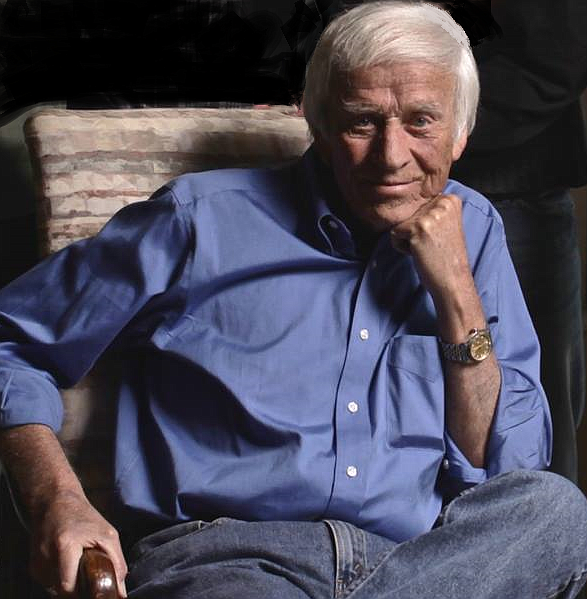Pat O'Day
February 1, 2019 at 12:00 a.m.
Pat O’Day – founding father of Northwest rock ‘n’ roll or the “Godfather” of the 1960s teen-dance scene? A vampire or the catalyst? Or all of the above?
There are many Northwesterners who would debate these points for days on end, but what is perfectly clear is that when it came to the business of rock music in the Northwest, Pat O’Day was the Chairman of the Board, the Grand Poobah, the Top Dog, the Big Kahuna. New York City had Alan Freed, Boston had Arnie Ginsberg, Los Angeles had Hunter Hancock and Seattle had O’Day. As Seattle’s highest-profile DJ of the 1960s and the region’s dominant dance promoter, Pat O’Day ran Northwest rock ‘n’ roll for nearly a decade.
Radioman of the Year
In 1964 and 1965, the national radio industry acknowledged his power, voting him top Program Director. In 1966, O’Day was voted “Radioman of the Year” and was also honored (along with a select few other iconic radio men) with his own volume of the popular Cruisin’ LP series that featured his powerhouse patter wedged between compiled period hits.
O’Day’s name became synonymous with KJR, the station he ran for a decade and built into an empire. To really understand his impact, you’d have to consider the power of that station back then – it was not uncommon for KJR to boast of a 37 percent rating, an unheard of dominance by a radio station. Today that rating would be more than the market share of the top seven local stations combined! O’Day, KJR’s star DJ, was eventually promoted to Program Director and, by 1968, to General Manager. He oversaw the production of each week’s Fab-50 play-list – inclusion on this list was virtually the only way a record could become a hit in this area.
Additionally, O’Day produced or engineered numerous recordings by many of the top bands on the KJR play-list including the Wailers, the Viceroys, the Dynamics and the Casuals. And if that wasn’t enough, he also ran an extensive teen-dance circuit across the region – which was the most profitable part of his empire and perhaps the most visible. By 1962, O’Day was making more than $50,000 a year just from throwing dances. By the mid-1960s O’Day and Associates were presenting over 58 separate teen-dances a week throughout the state.
The Rock ‘n’ Roll Pie
When it came to Northwest rock ‘n’ roll, Pat O’Day had his finger in every pie. And there were more than a few local bands and promoters who wanted some of that pie. In 1967, three local businessmen slapped a $3 million federal anti-trust suit on O’Day, charging that he held a monopoly on the Northwest rock ‘n’ roll scene and suggesting that he had been involved in payola and kickbacks from the bands that KJR aired.
The legal actions took more than three years and included a highly publicized trial at which several local musicians testified (Merrilee Rush told the court that she and O’Day only exchanged Christmas gifts – a bottle of Jack Daniels for a smoked turkey). Eventually O’Day was exonerated of all charges and given a clean bill of health by the FBI and other investigators.
Still, O’Day’s power-base was weakened and he departed KJR – the station he had brought to prominence and dominance – in 1974 to develop his concert business. “The federal investigations cost me about $150,000,” O’Day said of that time. “But I’ve never been further behind than when I started out because I didn’t have anything when I started!”
The trial was not the first or the last time O’Day was involved in a financial controversy. Though his reputation was hurt by the charges, he wasn’t down for the count. He sold his teen-dance business (just when teen-dances were fading) and formed Concerts West, one of the world’s biggest concert promotion firms. O’Day had promoted the Beatles in 1964. In 1965 he had local garage rockers the Wailers open for the Rolling Stones, and the Northwest’s proto-punk cult legends the Sonics sharing the bill with the Kinks. By 1968, Concerts West was booking all the U.S. dates for the Jimi Hendrix Experience and O’Day was on the road with Seattle’s guitar legend.
O’Day couldn’t give up radio, though, and after selling Concerts West he parlayed his considerable wealth into ownership of a string of stations including KXA, KYYX and Honolulu’s KORL. But by 1982, O’Day was once again the center of controversy when his empire fell on hard times financially and The Seattle Times ran a feature story outlining his woes.
By 1983, he was facing bankruptcy, squeezed by a $10 million bank loan. He almost lost everything he had once had. But adversity seems just another everyday challenge for O’Day, and the saga of his long career in the radio industry is always adding new chapters.
Out of Tacoma
The opening chapter sees the radio legend’s birth in 1934 as Paul W. Berg, the son of a preacherman. His father for years had a radio ministry on Tacoma’s KMO, introducing Pat to the medium. He was raised in Bremerton and from his early youth he had only one dream: to be the afternoon man on KJR. He attended radio school in Tacoma and in September of 1956 landed his first job at a tiny Astoria, Oregon station. There, in between reading lost dog reports and funeral home ads, he eventually developed his “Platter Party” concept, which meant broadcasting rock hits from remote teenage sockhops on weekends – thus turning the previously sterile medium of radio into an “event.”
The young radio talent moved to Seattle in 1959, lured by station KAYO. It was there that he adopted the O’Day moniker, taking it from the name of a local high school, O’Dea. By the fall of 1959, he moved to KJR and only then did his dynasty begin.
From Sleepy to O’Day
That November, O’Day virtually turned the local rock ‘n’ roll scene (sleepy up until that point) upside down. First he hired the Wailers – then riding high with their national hit, “Tall Cool One” – to play at what was the first rock ‘n’ roll dance at the Spanish Castle, an old ballroom just south of Seattle. Before long, the Castle emerged as the region’s premiere dance hall and O’Day had his hand in almost every show there.
On the radio, O’Day was also shaking up the scene. For if radio is, as has been said, the “theater of the mind,” then Pat O’Day was surely the greatest mind-bender to ever grace Northwest radio. Almost singlehandedly, he transformed what radio was and helped mold the perceptions of thousands of teenagers into what it could be. Working with a bottomless bag of impromptu tricks and stunts, O’Day – who was blessed with one of the all-time archetypal radio voices – proceeded to capture the imagination of Seattle’s teenagers by mixing rock ‘n’ roll hits with a never-ending cast of zany on-air characters including “Granny Peters,” “Mr. KJR,” and “Wonder Mother.” The concept sounds old hat today but back in that day it was innovative, cutting edge and fun.
O’Day can also fairly claim credit to being one of the first DJs in the nation to experiment with an “Oldies” format. That was partially because back in the late 1950s rock ‘n’ roll was still so young few stations concerned themselves with yesterday’s hits. But O’Day was quick to understand that a classic song will always be a classic and he exploited this programming technique to its fullest.
Local Discs to the Top
But he also established KJR as a station that could – and did – make hit records (think: the Ventures’ “Walk – Don’t Run” and the Tijuana Brass’ “The Lonely Bull”). But perhaps more importantly, O’Day was one of the first DJs in the Northwest to realize the talent of the early local bands. Though O’Day has more than his share of detractors, one thing he cannot be faulted on was his commitment to local music – no other station in history has played as many local discs as the O’Day-fueled KJR. And not only did he play local records (and book the bands for his teen-dances), he made them hits and increased the interest in Northwest music around the nation to a level that wouldn’t again be attained (and surpassed!) until Seattle’s Grunge rock movement of the 1990s.
By the late 1960s, though, the bands O’Day pushed had already seen their better years and the style of radio he represented didn’t go over too well with the ‘freaks’ and hippies…many found his bombastic, wisecracking style to be the very embodiment of crass commercial radio. Great offense was taken when it was eventually revealed that it was the “devil” himself, O’Day, who had been the secret financier behind a prominent local concert promoter – Seattle’s version of San Francisco impresario, Bill Graham – who had been booking concerts at the Eagles Hall, the “hip” alternative to O’Day’s teenybopper dance scene. It seemed there was no escaping the guy’s presence.
Indeed, that Pat O’Day has more lives than a cat is evidenced by his decades of involvement in Northwest rock ‘n’ roll. And now, once again, the man seems to have a few more tricks up his sleeves.
Postscript
Pat O’Day is the author of It Was All Just Rock ‘n’ Roll, which details his work in radio and concert promotion.
At 84, Pat O’Day is alive and well. He has thrived as a survivor. He survived the ups and downs of his business empire, he survived a brain tumor (slow-growing and benign, but very large by the time it was discovered). And he survived alcoholism. O’Day entered Schick Shadel Hospital in 1986 for treatment. “I’ve enjoyed over 32 years of sobriety,” he reports.
O’Day was not only a patient, he remains a booster of the organization. He became the organization’s spokesperson and, with a group of investors, helped lead Schick Shadel out of bankruptcy to becoming a nationwide leader in the field.
“Today Schick Shadel is recognized as the most successful treatment in the United States for alcohol and drug addiction, with a 70% success rate after just a 10-day stay,” says O’Day. “My heart is in that place,” he adds. “It is another great Seattle-area innovation, just like Boeing and Microsoft. I’m proud of that place because it has saved so many lives.” He remains active with the organization and gives the key lecture to patients every ninth day.
O’Day lives in the San Juan Islands, where he is a successful real estate agent. His wife of 35 years, Stephanie, is an attorney on the islands. The couple have three sons (Garry, Jerry and Jeff), a daughter (Kelsey), four grandchildren and a great-grandson.
O’Day is still in demand for talks around the region, but he and his wife find time to take frequent trips to their vacation home in Sun Valley, Idaho. “I don’t ski anymore, but I go there to look at the sun!” says O’Day. “I was a wild skier and decided to put the skis away before I hurt myself. Same with my pilot’s license. I never made a mistake, and decided it was time to sell the airplane before I did.” He has since replaced his skis with golf clubs.
Pat O’Day’s advice for healthy aging: “Stay busy! You only get one shot on this Earth. How can you waste one day of it?”
This is an update to an original article by Peter Blecha that first appeared on HistoryLink.org, the free online encyclopedia of Washington state history. Peter Blecha is a staff historian with HistoryLink.org and former Senior Curator for Seattle’s music museum, EMP (today’s Museum of Pop Culture). He is also: the director of the Northwest Music Archives (http://nwmusicarchives.com/), and the award-winning author of books including: “Sonic Boom! The History of Northwest Rock” [2009], “Music in Washington: Seattle & Beyond” [2007], “Rock & Roll Archaeologist” [2006], “Taboo Tunes: A History of Banned Bands & Censored Songs” [2004], “Wired Wood: The Origins of the Electric Guitar” [1997]; “Rising Tides and Tailwinds: The Story of the Port of Seattle” [2011]; and “Chateau Ste. Michelle: The First Fifty Years” (1967-2017) [2017]. His current book project is a secret...
